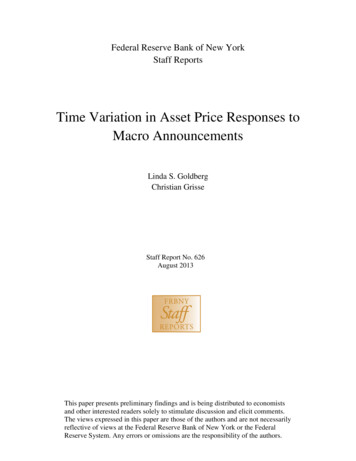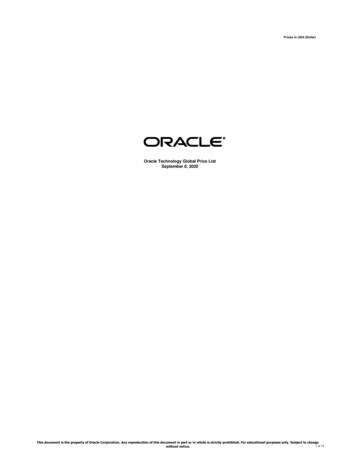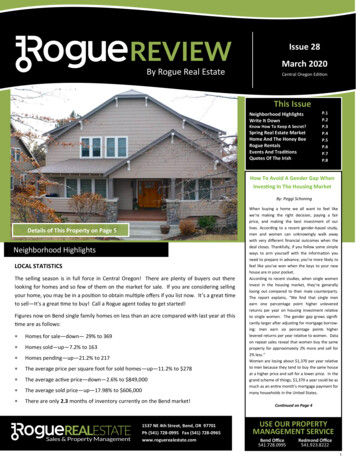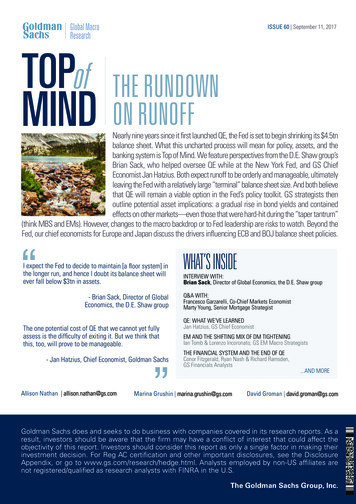
Transcription
EquityGlobal MacroResearchResearchTOPofMINDISSUE 60 September 11, 2017THE RUNDOWNON RUNOFFNearly nine years since it first launched QE, the Fed is set to begin shrinking its 4.5tnbalance sheet. What this uncharted process will mean for policy, assets, and thebanking system is Top of Mind. We feature perspectives from the D.E. Shaw group’sBrian Sack, who helped oversee QE while at the New York Fed, and GS ChiefEconomist Jan Hatzius. Both expect runoff to be orderly and manageable, ultimatelyleaving the Fed with a relatively large “terminal” balance sheet size. And both believethat QE will remain a viable option in the Fed’s policy toolkit. GS strategists thenoutline potential asset implications: a gradual rise in bond yields and containedeffects on other markets—even those that were hard-hit during the “taper tantrum”(think MBS and EMs). However, changes to the macro backdrop or to Fed leadership are risks to watch. Beyond theFed, our chief economists for Europe and Japan discuss the drivers influencing ECB and BOJ balance sheet policies.“I expect the Fed to decide to maintain [a floor system] inthe longer run, and hence I doubt its balance sheet willever fall below 3tn in assets.- Brian Sack, Director of GlobalEconomics, the D.E. Shaw group“The one potential cost of QE that we cannot yet fullyassess is the difficulty of exiting it. But we think thatthis, too, will prove to be manageable.- Jan Hatzius, Chief Economist, Goldman SachsAllison Nathan allison.nathan@gs.comWHAT’S INSIDEINTERVIEW WITH:Brian Sack, Director of Global Economics, the D.E. Shaw groupQ&A WITH:Francesco Garzarelli, Co-Chief Markets EconomistMarty Young, Senior Mortgage StrategistQE: WHAT WE’VE LEARNEDJan Hatzius, GS Chief EconomistEM AND THE SHIFTING MIX OF DM TIGHTENINGIan Tomb & Lorenzo Incoronato, GS EM Macro StrategistsTHE FINANCIAL SYSTEM AND THE END OF QEConor Fitzgerald, Ryan Nash & Richard Ramsden,GS Financials Analysts.AND MOREMarina Grushin marina.grushin@gs.comDavid Groman david.groman@gs.comGoldman Sachs does and seeks to do business with companies covered in its research reports. As aresult, investors should be aware that the firm may have a conflict of interest that could affect theobjectivity of this report. Investors should consider this report as only a single factor in making theirinvestment decision. For Reg AC certification and other important disclosures, see the DisclosureAppendix, or go to www.gs.com/research/hedge.html. Analysts employed by non-US affiliates arenot registered/qualified as research analysts with FINRA in the U.S.The Goldman Sachs Group, Inc.
Top of MindIssue 60Macro news and viewsElWe provide a brief snapshot on the most important economies for the global marketsUSJapanLatest GS proprietary datapoints/major changes in viewsLatest GS proprietary datapoints/major changes in views We lowered our Q3 GDP tracking estimate by 0.8pp to 2.0%on hurricane effects; however, we expect growth to reboundand raised our Q4, Q1, and Q2 GDP forecasts by 0.4pp,0.2pp, and 0.4pp, respectively, to 2.7%, 2.5%, and 2.4%. We raised our Q3 GDP tracking estimate to 1.2% qoq ann.from 0.5% previously, reflecting July data and a smallerpullback effect from Q2 GDP, which was revised to 2.5%qoq ann. from 4.0% (mainly on private capex).Datapoints/trends we’re focused onDatapoints/trends we’re focused on Shifting fiscal risks, as the structure of the recent debt limitextension will likely make the next debt limit increasenecessary by March; we believe this lowers the odds of taxlegislation being enacted in 2018, to around 40%. A post-crisis high in the August Reuters Tankan survey ofmanufacturers, driven by external demand and stable forex. Evidence that Japanese consumers have become moreprice-sensitive over time—likely a key drag on inflation.The hit from hurricanesSentiment on the riseHurricane property damages as a % of US GDPManufacturing DI (lhs) vs. IP, indexed to 100 in 2010 3010310120991097095Reuters:Manufacturing DI (lhs)-109391-20Abenomicsbegins-30Industrial production,indexed (2010 100,rhs)VAThike-40Source: National Hurricane Center, Goldman Sachs Global Investment Research.878510*Preliminary estimates. Assumes 85bn in total damages.8911121413151617Source: Thomson Reuters, METI.EuropeEmerging Markets (EM)Latest GS proprietary datapoints/major changes in viewsLatest GS proprietary datapoints/major changes in views We raised our 2017 GDP growth forecast for France to 1.6%from 1.2%, incorporating better-than-expected data; andupgraded Italy to 1.4% from 1.0% on expectations for fiscaleasing. We forecast Euro area GDP growth of 2.2% in 2017and expect a mild deceleration in H2 relative to H1. No major changes in views.Datapoints/trends we’re focused onDatapoints/trends we’re focused on A synchronized upswing in growth across EM, which mayportend a longer period of EM economic expansion. A rise in August China manufacturing PMIs, pointing to solidactivity growth going into the Party Congress in October. Signs that the ECB will increasingly use forward guidance onrates, particularly when tapering begins (likely next year). A larger-than-expected deceleration in India’s growth in Q2. Strong support for Merkel’s party ahead of the Germanelections, suggesting policy continuity to a large extent. The recent downside surprise in Russian inflation; the centralbank said it will consider a cut of 25bp or 50bp this month.A vote for continuitySynchronized recoveries tend to last longerAvg. German voting intentions across five main opinion polls, %Length of economic upswings and levels of growth dispersion4528CDU victory inkey state elections40Length of the recovery, quarters (lhs)Avg. growth dispersion - standard deviation (rhs, inverted)Avg. growth dispersion - percentile range (rhs, inverted)2402352030Martin Schulzwins More synchronizedEM growth12881041050Minimum threshold to enter the German parliament (Bundestag)Jan-16May-16Sep-16Source: Wahlumfragen.de.Goldman Sachs Global Investment ResearchJan-17May-170Sep-17Q3-01 Q4-07Q3-98 Q3-00Q3-92 Q4-93Q1-09 Q1-10Q4-15 todaySource: Haver Analytics, Goldman Sachs Global Investment Research.2
Top of MindIssue 60The rundown on runoffElNearly nine years since it first launched Quantitative Easing(QE), the Fed is finally set to begin shrinking its 4.5tn balancesheet. What this uncharted process means for policy, assetmarkets and the banking system is Top of Mind.conviction in inflation remaining low and runoff substituting forrate hikes, even a small shift in investor expectations could leadto a sharp sell-off in bonds. Again, this is not our mainline view,but a risk to keep in mind.We kick off with a retrospective from GS Chief Economist JanHatzius on the lessons learned from QE. In short, he concludesthat balance sheet expansion was an effective policy tool thatcame with fewer costs than many observers had predicted. Atthis point, he sees just one potential unknown downsideassociated with QE: the difficulty of exiting it. But with financialconditions easing this year even as the expected timing ofnormalization has been pulled forward, Hatzius is optimisticthat the process will be orderly and manageable.Looking beyond the markets to the banking system itself,some observers have raised concerns that draining QE-relatedliquidity could trigger deposit outflows, potentially leading tofunding stress. However, our Financials equity analysts take amore sanguine view. Their analysis suggests that banks havetreated most deposits created by QE as short-term liquidityrather than reliable, longer-term funding. Moreover, post-crisisrules require that banks hold safe assets against these depositsdollar-for-dollar, further preparing them to manage anyoutflows. Slower deposit growth as the Fed unwinds QEshould therefore be fairly manageable for banks. Butnormalization may have other effects: The team flags higherinterest rates for consumers and a likely uptick in bank M&A astwo likely consequences.Brian Sack of the D.E. Shaw group, who helped design andoversee QE while at the New York Fed, is similarly confidentthat balance sheet runoff will go smoothly, even if it ultimatelyoverlaps with ECB tapering as we expect. In Sack’s view, thisis not only because the Fed has clearly communicated its plans,but because the expectation that QE is redeployed in the futuremay keep some downward pressure on the term premium (thecompensation for duration risk in long-term bonds). He alsoreiterates his long-held view that the balance sheet’s “terminalsize” should be larger than in the past, and doubts the balancesheet will ever dip below 3tn again. Our US economics teamgenerally agrees, and digs further into the mechanics ofbalance sheet policy on pgs. 8-9.So what would such an orderly normalization look like for bondsand other assets? We expect QE’s fading portfolio balanceeffects to add an estimated 20bp to 10-year Treasury yields thisyear, 15bp next year, and 10bp/year from 2019-2021, which webelieve should prove digestible for both US equities andcorporate bonds (see pg. 11). And in the EM space, GSstrategists Ian Tomb and Lorenzo Incoronato see little risk ofanother “taper tantrum,” as solid growth and improvedexternal balances have put EMs in a better position than beforeto weather increases in US/core rates. That said, they see amore favorable outlook for EM equities, FX, and credit spreadsthan for local bonds, where investors will need to be moreselective going forward.Even in mortgage-backed securities (MBS), where the Fedowns roughly 30% of outstanding agency securities, we thinkthe impact of runoff will most likely be limited. Indeed, GSSenior Mortgage Strategist Marty Young points out that,against expectations, MBS spreads have actually tightened thisyear. He anticipates only modest spread widening from here—not enough to justify a short position. A more notable outcomeof the QE unwind, in his view, could be its effects on volatility;Fed ownership of MBS has likely suppressed rate vol in recentyears, suggesting that vol could eventually pick up as moresecurities shift back into the hands of private investors.So what could go wrong? For one, future changes to Fedleadership have the potential to alter the FOMC’s runoff plans.And GS Co-Chief Markets Economist Francesco Garzarelliemphasizes that the rates market’s reaction to runoff—whichwill likely drive other asset markets’ responses—is entirelycontingent on the macro backdrop. Given the market’sGoldman Sachs Global Investment ResearchGiven that the Fed is not the only central bank carefullymanaging its balance sheet policies, we also take theopportunity to assess the state of asset purchase programs atthe ECB and the BOJ. GS Chief European Economist Huw Pillreminds us that the ECB is no stranger to shrinking its balancesheet, which fell from EUR 3.1bn in 2012 to just over EUR 2bnin 2014. Reassuringly, the process went smoothly—althoughthat contraction reflected reduced demand for central bankliquidity, not a deliberate policy decision. While ECB tapering(which we expect next year) is likely to have bigger implicationsthan this earlier experience, Pill argues that those implicationswill likely depend more on the composition of the centralbank’s balance sheet than the size.While all eyes are on the Fed and the ECB, it’s worth pointingout that the BOJ has already been quietly reducing itsJapanese government bond purchases for almost a year. Thishas led some market participants to expect the BOJ to lower orabandon its purchase target. However, GS Chief JapanEconomist Naohiko Baba believes that the central bank has nointention of doing so, lest that result in appreciation of the yen.Instead, he expects the BOJ to proceed with the status quo fornow, as reaching even 1% inflation, let alone the 2% target,appears all too remote. That said, with a new BOJ governortaking the helm in April 2018, this is a place to watch.With all of this talk about exit policies, a closing thought aboutfuture easing (whenever the economy next requires it). AsHatzius points out, even if rates ultimately rise to the 3.253.50% range as we expect, this may not leave enoughconventional easing capacity to sufficiently address the nextshock. In other words, an eventual return to balance sheetexpansion may very well be in the cards.Allison Nathan, EditorEmail: allison.nathan@gs.comTel:212-357-7504Goldman Sachs and Co. LLC3
Top of MindIssue 60QE: what we’ve learnedElJan Hatzius argues that balance sheet growthachieved its aims at relatively low costs—andmay eventually return as a policy toolThe Federal Reserve stands on the cusp of balance sheetrundown, and the ECB is moving gingerly toward the exit aswell. What lessons have we learned about quantitative easing(QE), and what are the implications for the future conduct ofmonetary policy?QE is quite effectiveThere is now a great deal of research covering the effects ofQE in the US, the Euro area, the UK, and Japan. One strand ofthis research focuses on the impact of surprise QEannouncements on bond yields and other financial variables.This is a good approach for showing that QE has significantshort-term effects on financial conditions but is less suitable forpinning down magnitudes and long-term effects. Anotherstrand of research estimates equations for the level of bondyields or the term premium as a function of QE and othereconomic control variables. This allows us to quantify themedium-term effects of asset purchases and therefore nicelycomplements the first approach.Taken together, these studies suggest that QE lowers the levelof bond yields by 3-5 basis points for each 1% of GDP.Moreover, it is generally the expected stock of central bankbond holdings that matters, not the ongoing flow of centralbank bond purchases. This is particularly clear in the US, whereflow effects are largely absent in the data. In the Euro area, theevidence is m
Research Global Macro Research Goldman Sachs does and seeks to do business with companies covered in its research reports. As a result, investors should be aware that the firm may have a conflict of interest that could affect the objectivity of this report. Investors should consider this report as only a single factor in making their investment decision. For Reg AC certification and other .




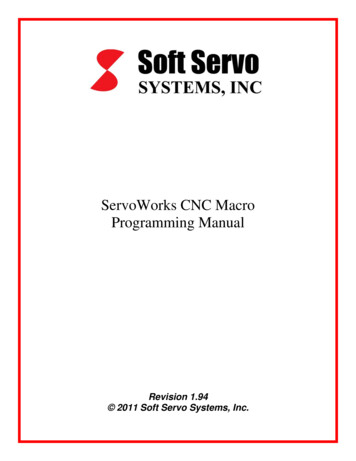
![[MS-OFFMACRO]: Office Macro-Enabled File Format](/img/3/5bms-offmacro-5d-130211.jpg)
![[MS-OFFMACRO2]: Office Macro-Enabled File Format Version 2](/img/3/ms-offmacro2.jpg)
